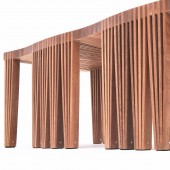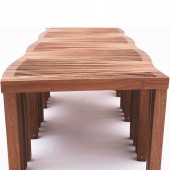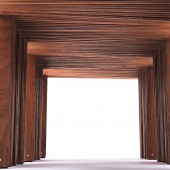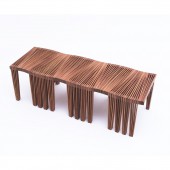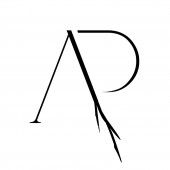Optique Bench by Albert Potgieter |
Home > Winners > #129032 |
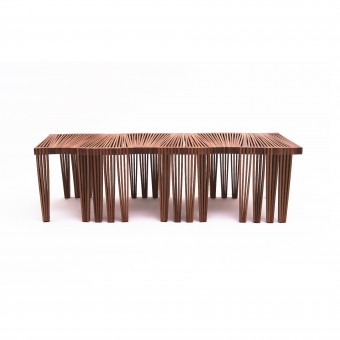 |
|
||||
| DESIGN DETAILS | |||||
| DESIGN NAME: Optique PRIMARY FUNCTION: Bench INSPIRATION: Many of Albert Potgieter's inspiration comes from the awe of observing nature, the lines and shapes that it produces. The Optique Bench design is no exception. The inspiration came whilst being on the family game farm in South Africa, observing tree lines, golden grass fields waving in the wind and the many intricacies of the bushveld. The design idea that started in South Africa, together with the need to produce an environmentally friendly design by using off-cut pieces of wood, turned into the first prototype of the Optique bench. This design still carries those raw, wild yet linear lines and awe that is seen in nature. UNIQUE PROPERTIES / PROJECT DESCRIPTION: The Optique bench was designed to be a functional art piece. To be a unique furniture piece in the house, but that also gives an atmosphere to the room it’s in. The uniqueness of this design lies in its visual aspect, hence the name, Optique. It captures the attention as it gives the impression of movement and being alive. Being designed in Africa it also carries the properties of nature and wildness with it, giving it a very special, unique look. The core of the design is to attract, to gather around and to enhance the space it fills. OPERATION / FLOW / INTERACTION: The Optique Bench is considered functional art- it has the ability to create an atmosphere of comfort and community, while it also has the ability to initiate conversation as only art can while you are admiring the visual aspects of the design. It was designed to be visually attractive while still being used functionally and through this, has the ability to change the atmosphere of a home. PROJECT DURATION AND LOCATION: The designing process started in December 2018 on the Family game farm in South Africa, and the production was finalized in February 2019 in Rotterdam, Netherlands FITS BEST INTO CATEGORY: Furniture Design |
PRODUCTION / REALIZATION TECHNOLOGY: The Optique Bench came to be in a very unique way. Only an idea or part was designed on paper at first, when Albert jumped into the building process. This turned the building and designing process into one and as a result, caused the bench to form organically into the piece it is today. The Optique Bench is all handmade in solid hardwood. Piece by piece it’s cut, set in the right position, glued together and slowly it is built up into bigger and bigger pieces. Only wood and glue is used in the production of the Optique Bench while a tiny bolt is used in the bottom of the leg to give a bit of detail. SPECIFICATIONS / TECHNICAL PROPERTIES: Length 1600mm x Width 550mm x Height 450mm TAGS: bench, interior, handmade, seating, home, art, living room, design RESEARCH ABSTRACT: Research, when it comes to designing, cannot necessarily be define as something specific or to a date or time. It is a way of living, keeping your eyes open to what is around you. Seeing the abstract forms or the natural lines of nature outside. The cracks and grooves in a tree trunk, the way leaves are scattered on the ground, the shapes it makes, the ripples in water when the wind blows over it. That is the kind of constant research that in the end accumulates and comes together into a product, such as the creation of the Optique Bench. CHALLENGE: The hardest part of this design was to make the Optique Bench strong enough so that it can be moved around etc. Since there are so many joints, this can cause a problem in durability. The first prototype was made by using screws at every joint, but this causes the wood to split in some places and it is actually not as strong as wood glue. In the second bench, no screws were used, only wood glue. The joints were strong to use and sit on, but moving the bench around too much caused some of the joints to split open slightly. A solution was found by strengthening every joint with a wooden dowel or domino, causing the bench now to be strong for use and for transport. The other creative challenge was getting the wood pieces in the legs in exactly the right angle so that when you put the joints together it doesn’t split open in the back of the joint or has a gap in the front of the joints. This was overcome after a few trials and making a mold, where every piece of wood, that is used in the legs, gets put into the mold one by one and put through the planer before being glued. Another creative challenge was the finishing phase. As a result of using the individual pieces of wood and the gaps between each piece, it is difficult to sand and oil everywhere and inevitably adds an enormous amount of time. This can cause inconsistencies in the aesthetics of the Bench if not done properly. However, this is overcome by sanding and oiling every individual piece before gluing, excluding the portions that will be glued together. ADDED DATE: 2021-07-29 06:38:39 TEAM MEMBERS (1) : IMAGE CREDITS: Image #1: Photographer Martijn Roos, Optique Bench, 2020 Image #2: Photographer Martijn Roos, Optique Bench, 2020 Image #3: Photographer Martijn Roos, Optique Bench, 2020 Image #4: Photographer Martijn Roos, Optique Bench, 2020 Image #5: Photographer Martijn Roos, Optique Bench, 2020 |
||||
| Visit the following page to learn more: http://albertpotgieter.com | |||||
| AWARD DETAILS | |
 |
Optique Bench by Albert Potgieter is Winner in Furniture Design Category, 2021 - 2022.· Press Members: Login or Register to request an exclusive interview with Albert Potgieter. · Click here to register inorder to view the profile and other works by Albert Potgieter. |
| SOCIAL |
| + Add to Likes / Favorites | Send to My Email | Comment | Testimonials | View Press-Release | Press Kit | Translations |
| COMMENTS | ||||||||||||
|
||||||||||||

